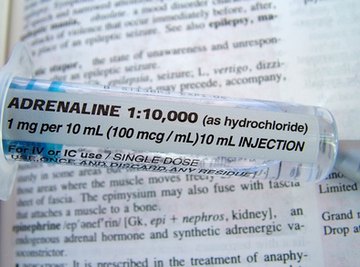
Catecholamines and cortisol are both chemical messengers in the human body, and both are involved in the human stress response, among other functions. Catecholamines are a group of chemicals that include epinephrine, norepinephrine, and dopamine, all of which function both as neurotransmitters and as hormones in the body. Cortisol is a single chemical whose main functions include the regulation of metabolism, as well as the regulation of other hormones.
Synthesis and Chemical Structure
Cortisol is synthesized and released by the human adrenal cortex, the outermost portion of the adrenal glands, located just above each kidney, whereas catecholamines are synthesized in the adrenal medulla of the brain, as well as inside some sympathetic nerve fibers.
Catecholamines contain a benzene ring with adjacent hydroxyl groups and an amine group on the side chain, according to "The Bantam Medical Dictionary." Cortisol is synthesized from cholesterol and transformed first into progesterone and then into 17-OH-Progesterone, 11-Deoxycortisol, and finally into cortisol by the action of various enzymes.
Site of Action
Receptors for catecholamines are found throughout the body. Epinephrine, also known as adrenaline, can quickly increase heart rate, rate of respiration, and rate of re-absorption of water and signal other subtle changes in the body that facilitate the fight-or-flight response. The effects of cortisol can be seen only after 30 minutes at the earliest and usually not for hours or days. Norepinephrine, a chemical related to epinephrine, can signal the release of cortisol to prepare the body for long-term stress. Cortisol inhibits growth and reproductive functions and establishes a metabolism suited to quick action or future famine, such as high blood sugar and the storage of fat.
Disease of Excess
An excess of cortisol can result in a condition known as Cushing's syndrome. This disease can result from injury or tumors on the adrenal glands or other glands in the body or from taking certain medications, such as prednisone, for a prolonged period of time. Cushing's syndrome is characterized by a lump of fat between the shoulders, rounded face, and progressive obesity and can lead to high blood pressure, bone loss, and occasionally diabetes. Excessive levels of catecholamines, or the hyperactivity of catecholamine receptors, is believed to be associated with certain types of psychosis, which can be treated by dopamine receptor inhibitors such as the drug chlorpromazine.
Disease of Deficiency
A deficiency of cortisol, caused by damage to or disease of the adrenal glands can lead to Addison's disease, characterized by muscle weakness, fatigue, low blood pressure, low blood sugar, irritability, and depression, among other symptoms. The degradation of receptors for catecholamines, specifically for dopamine, is associated with the muscular tremors and rigidity of Parkinson's disease, which can be partially treated with L-dopa, a drug that is a dopamine precursor.
References
- "Physiology, 4th Edition"; R. M. Berne et al; 1998
- Britannica: Catecholamines
- "The Bantam Medical Dictionary"; Bantam Books; 2000
- Mayo Clinic: Cushing's Syndrome
- Mayo Clinic: Addison's Disease
Photo Credits
adrenaline injection image by Keith Frith from Fotolia.com
